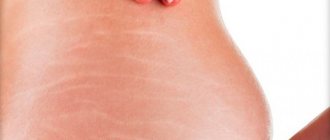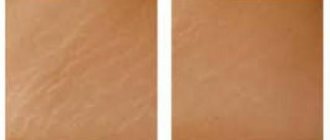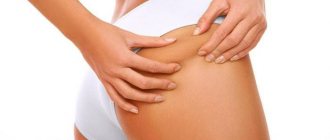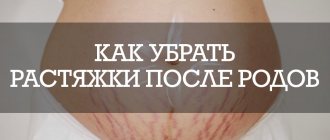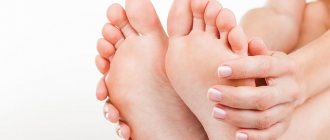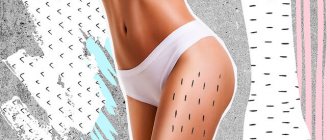What do stretch marks look like on legs?
Striae on the knees
Doctors note that most often stretch marks (striae) in the knee area are an aesthetic defect, but not a serious illness. Such problems cause particular concern among women, since they cannot wear beautiful, open clothes in the warm season.
Subcutaneous scars can be white, red, blue, but they are always uneven and have a rather wide base. Scar changes in the skin differ in width, depth, location, and color. On the legs, stretch marks appear under the knees, on the calves and in the thigh area.
Blue and red stretch marks on the legs are fresh scar changes that are less than 1 year old. The bright color of the changed skin indicates the receipt of blood supply to the vessels and tissues, since changes in blood flow take time. The damaged areas sometimes itch, and at this time the torn fibers in the subcutaneous layers heal. The problem of eliminating red stretch marks has an easy and quick solution, but it is advisable to start treatment in a timely manner.
White stretch marks on the legs are old scars. To remove such scar changes, serious financial investments in the procedure are required. Home treatments reduce the appearance of blemishes, making them less noticeable. Modern hardware cosmetology and special procedures make it possible to remove stretch marks in the shortest possible time.
Causes of stretch marks on legs
Red stretch marks on the leg
Many people try to understand why stretch marks may appear on the legs and knees. Various reasons cause this problem.
If stretch marks appear under the knees, the causes of which remain unclear, you cannot do without medical help:
- Sudden weight changes lead to unwanted scarring of the skin. After active weight loss, the adipose tissue under the skin does not have time to stretch, resulting in its rupture. After rupture of adipose tissue, scar changes appear on the legs.
- Pregnancy puts extra stress on the legs, so serious undesirable changes related to the skin are expected.
- Puberty. During this period, serious changes often occur in the human body, as active growth leads to various changes. Striae can appear on the legs of boys and girls.
- Use of certain drugs. Striae can be caused by the use of corticosteroid ointments, creams and tablets. Not all products are suitable for knees. Negative hereditary predisposition. In some cases, stretch marks are inherited in women.
The above reasons are the most serious, so the appearance of stretch marks on the legs deserves attention and consultation with a doctor.
Prevention of stretch marks
It is easier to prevent stretch marks on the legs than to try to get rid of them later. Those who are at risk need to take extra care of their skin. To avoid the appearance of unpleasant stripes on the legs, it is recommended to take preventive measures:
- Proper nutrition. Eating enough protein, vitamins and microelements makes the skin elastic.
- Cold and hot shower.
- Moisturizing and nourishing the skin with creams, cosmetic milk and other cosmetics.
If stretch marks do appear on your legs, you need to get rid of them immediately.
Fact! The sooner you take the necessary measures, the easier it is to remove this cosmetic defect.
Fresh stretch marks are those that appeared no later than 6 months. It is much more difficult to get rid of old stripes, sometimes only through surgery.
You can remove stretch marks using the services of professionals or try to do it yourself at home.
Why stretch marks appear in children and teenagers
Striae on the legs of a child
Stretches on the knees of teenagers and children are one of the main causes of worry for parents. Scarring skin changes in adolescence are among the most undesirable, but still they are not considered a death sentence. Vertical striae in children and adolescents disappear after a few months or a couple of years. You shouldn't expect stretch marks to disappear on their own.
The causes of stretch marks may be the same as in adults:
- insufficient physical activity;
- rapid weight loss or gain;
- sudden puberty.
Diagnosis is mandatory, since hormonal imbalances and diseases of internal organs lead to unwanted health problems.
Treatment for stretch marks can take a long time, since hormonal imbalances cannot be corrected promptly. Teenagers usually require special salon procedures:
- Mesotherapy is an effective way to get rid of stretch marks. A special medicine is injected into the changed skin using a thin needle. The drug activates skin regeneration and improves appearance.
- Laser resurfacing is an expensive and time-consuming procedure. During the treatment course, the teenager will have to suffer from a slight burning sensation of the skin.
- Cosmetics are affordable and effective, so cosmetic products are used to improve the skin around the knees.
If a child has vertical stretch marks under the knees, a doctor’s consultation is required for further action and possible treatment.
What complications are possible after treatment for spider veins?
- Superficial necrosis
Removal of telangiectasia can be compared to microsurgery. Phlebologists use special magnifying glasses and illuminators for precise injections into the lumen of spider veins on the skin. Such equipment and the experience of a phlebologist make it possible to make an injection precisely into a microscopic vessel, without introducing sclerosant into the thickness of the skin. If the drug is injected intradermally, punctate necrosis sometimes occurs - small ulcers that do not need to be treated and they heal with small whitish scars.
- Deep necrosis
Another dangerous complication of microsclerotherapy can be injection into an arterial vessel. Entry of sclerosant into such a vessel can cause spasm of the cutaneous arteries and major skin necrosis, which may require long-term treatment and may heal with the formation of a rough scar. This is not the phlebologist’s big fault, but the doctor’s experience in choosing a vessel for injection is very important. Upon detailed examination under magnification, it is possible to distinguish a venous vessel from an arterial one and make the right choice. If the puncture site hurts, or if spots or blisters appear in the injection area, you must immediately inform the phlebologist about this condition.
- Microburns during laser treatment and RFO.
These thermal treatments involve heating and welding the vessels. Due to this, a cosmetic effect is achieved. However, in the hands of an inexperienced specialist, laser coagulation can lead to skin burns due to too long exposure to radiation. Most often, the area of this burn is very small and can clinically appear only as a crust, but sometimes there are deeper skin lesions that form rough scars.
- Meshing and hyperpigmentation after microsclerotherapy.
In approximately 10% of patients treated for intradermal vessels, a very thin venous network, called meting, develops in place of the disappeared asterisk. The occurrence of this problem is impossible to predict and very difficult to combat. Metting more often appears after conventional microsclerotherapy without the use of cold; somewhat less frequently, this problem occurs after laser coagulation and RFO. After the appearance of metting, it is better to stop any attempts to combat the asterisks, since practice shows the impossibility of solving this problem with the help of additional sclerotherapy or laser. Over time, this resulting smoky network may decrease on its own or disappear completely.
Hyperpigmentation is not scary, it will definitely go away, but it can take quite a long time. The appearance of the legs after treatment may not satisfy the patient for six months to two years. To prevent this complication, it is necessary to tell the doctor your contraceptive regimen and receive recommendations for contraception during the course of therapy.
In our clinic, a full course of sclerotherapy on the hips begins a month after the first trial session, at which the rate of disappearance of the venous network and the likelihood of complications are assessed. Depending on the results obtained, a decision is made on the timing of the further course of treatment.
- Early relapse of telangiectasis
No patient is immune from the reappearance of new telangiectasis after microsclerotherapy of the lower extremities. The reasons for the appearance of stars on the skin have not been fully established, but the most recognized theory is the postulate of an imbalance of female sex hormones in the body. The levels of these hormones may be normal, but their ratios are different. This is why it is impossible to predict the duration of the aesthetic effect after microsclerotherapy and laser treatment. Relapses are possible, but if these wreaths disappeared well after the first course of treatment, then they will disappear just as well after subsequent ones. In the hands of an experienced phlebologist, complete success in the aesthetic treatment of telangiectasia is usually achieved.
How to remove stretch marks on legs in adults
Laser resurfacing
You can remove stretch marks on the legs around the knees in adults using modern clinical and salon techniques and cosmetic products:
- Laser therapy. Fractional lasers reduce stretch marks and sometimes remove them completely. A course is required to achieve the desired effect. The number of procedures depends on the severity of the condition and the type of skin.
- Cosmetics. The modern market offers various cosmetic products used to combat stretch marks. Experts note that medicinal cosmetics help in the initial stages and during prevention.
- Mesotherapy. This method is considered the most popular and effective. The specialist prepares a medicinal mixture, injected under the skin with a special roller with thin small needles. Mesotherapy normalizes the production of collagen and elastin to eliminate stretch marks.
- Cosmetic surgery. Surgery is required for large stretch marks and sagging skin.
- Chemical peeling. In this procedure, chemicals are applied to the skin, after which the skin dies and heals. The dying process is required for further active reproduction of healthy skin cells.
The above methods help to successfully get rid of stretch marks for adults and adolescents.
Professional correction methods
Surgical and cosmetic procedures are recognized as the most effective methods. And although with their help it is possible to cope with stretch marks, without proper care it will not be possible to prevent the appearance of new stretch marks. The most popular procedures include the following:
- Laser therapy. During laser resurfacing, the top layer of skin along with scar tissue is removed. During the recovery process, the body replaces striae tissue with healthy one. Chemical peeling. Under the influence of acids, the upper layers of the epidermis are removed, and skin cells are renewed.
- Mesotherapy. A very popular method. Using a special roller with many thin needles, a cocktail of medicinal preparations is injected under the skin, which promotes the production of collagen and elastane in the damaged skin.
- Biorevitalization. Hyaluronic acid is injected into damaged skin by injection. This leads to rapid restoration of the skin, as a result of which stretch marks become much less noticeable.
- Botulinum therapy. Injections of Botox or other drugs of similar effect are used. Under their influence, the skin is evened out.
- Cosmetic surgery. Used as a last resort when other methods are powerless.
Ways to treat stretch marks at home
To eliminate stretch marks on the legs, it is possible to use folk remedies and available methods:
- Massage with oil mixtures, natural honey or cupping is considered effective. When using oil mixtures, it is possible to use the following product: a quarter of avocado oil is mixed with essential oils of jasmine, neroli, red tangerine, rosemary and lavender (10 drops each). The oil is infused in a dark place for a day, after which it is used for the procedure.
- Algae wraps are considered effective for red and blue stretch marks. This procedure takes about 30 minutes.
- To eliminate stretch marks, you can use a special product made from cocoa butter, olive oil, sesame oil, soybean and wheat germ. Accelerated regeneration improves the condition of the skin of the feet.
- Thalassotherapy involves the use of sea mud and salt. Minerals penetrate the skin for subsequent restoration. The procedure lasts no more than 25 minutes. Cosmetological and home methods for eliminating stretch marks are considered effective.
Stretch marks behind the knees go away with proper skin care and a healthy lifestyle.
